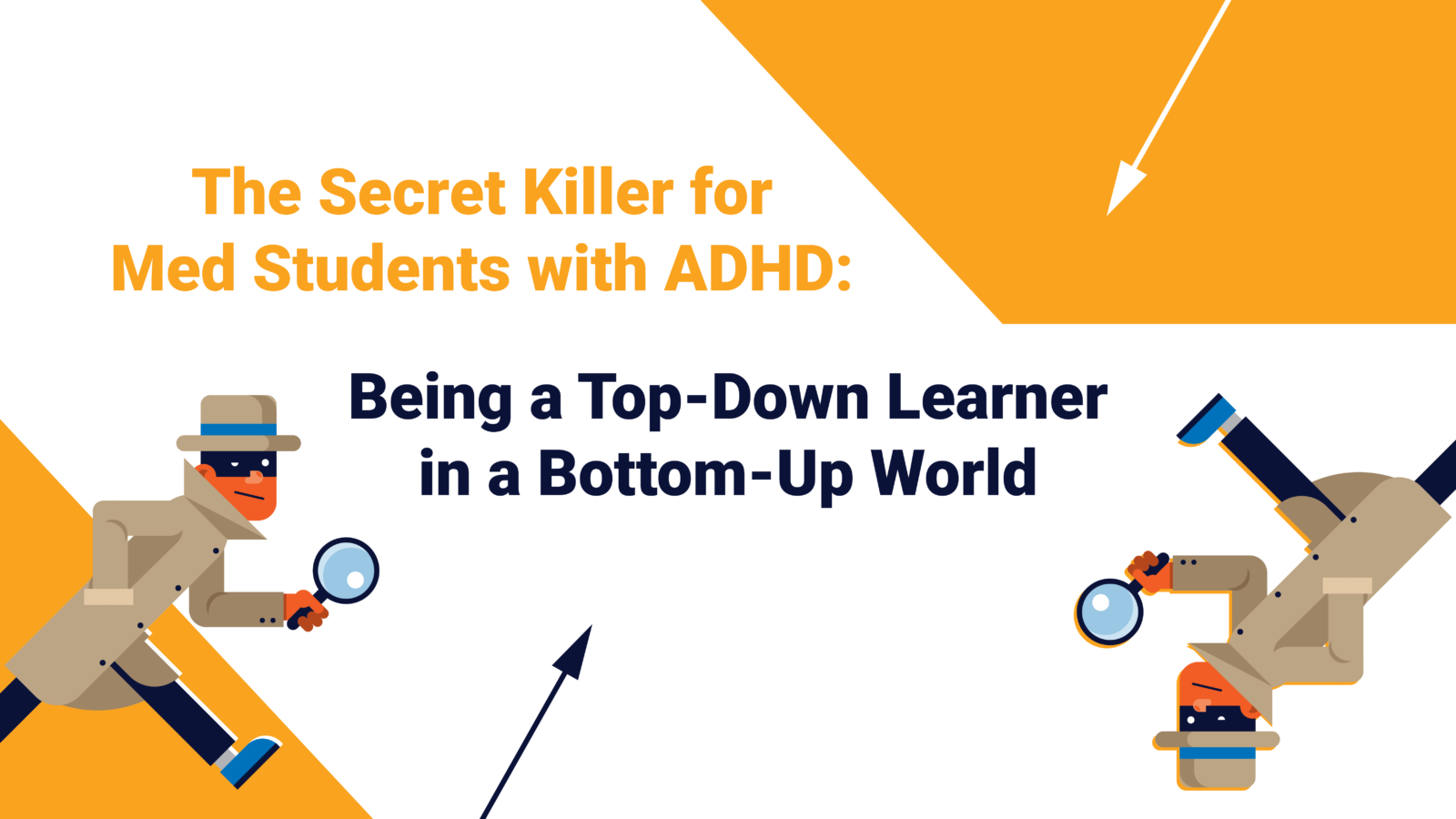Being a Top-Down Learner in a Bottom-Up World
Learning has to start with finding structure.
This gets harder in med school because of the staggering speed-volume-density equation — there’s so much to learn so fast.
If you have ADHD, this whole structure-finding endeavor might be harder for you than for most of your med school peers.
Why is that the case? These peers without ADHD are mostly gifted learners who can learn from a detail-first perspective:
- I believe most med students fall into this category, which we can call BOTTOM-UP LEARNERS.
The learning literature calls them HIGH STRUCTURE BUILDERS, meaning they are cognitively wired to learn from fragmented details and will subconsciously and implicitly build the STRUCTURE to contain the details, even in dense learning situations like in med school and on boards.
This can apply to learning in a super-dense lecture, studying from dense textbooks or review books, learning from disconnected online video series, or studying from a fragment-first system like ANKI.
When we think about the majority of med students who “just get it” in med school, from lecture-based learning to primarily learning through practice questions, we are likely talking about students who are gifted with high structure builders who can learn from the bottom-up. - But what about the med students who are the opposite? You can be a med student who is a LOW STRUCTURE BUILDER who needs to learn from the TOP DOWN, meaning you need to find the organizational super-structure of a lecture or reading event BEFORE trying to encode the details.
And here’s the key: Most of the med students I meet with ADHD who are unhappy with their med school performance fall into this category of being low structure builders.
They say things like this:
- “I get nothing from lectures!”
- “ANKI doesn’t work for me… but I feel like it should since it works for everyone else….”
- “How can I learn from just doing practice questions?”
- “I’m overwhelmed with all the stuff I have to learn and don’t even know where to begin!”
These issues all stem from some aspect of executive dysfunction, which we expect to see with many struggling medical students with ADHD. These issues come from being a top-down learner and a low-structure builder. Those who thrive in these areas are likely the opposite, which is partly why this is all so frustrating.
Quick caveat: If you have ADHD and do not experience these issues, that’s great! Good for you! Then this does not apply to you. And likewise, you might not have ADHD, but you can certainly still be a top-down, low-structure builder who needs help! These are neither mutually inclusive nor exclusive.
So these medical students with ADHD are what we call LOW STRUCTURE BUILDERS, and we can consider them to be TOP DOWN LEARNERS:
- They need to explicitly find and build the organizational framework before being able to rapidly encode, store, and eventually retrieve the details.
- This applies to a single lecture, a lecture series, a textbook, a review book, etc.
- If they struggle, they are likely finding structure too late, too inconsistently, or never.
- They often struggle to get consistent value from med school lectures or other dense or fragmented learning environments, like learning straight from ANKI or doing practice questions. Once they have the structure, then they can benefit from these tools, so it becomes a matter of finding structure first and fast.
Keep in mind this applies across the spectrum of medical education, from lecture-based learning to board review programs to independent study like on rotations or in residency. It also applies to problem-based learning models (PBL) and other curricular designs. Likewise, this all applies to those in related fields like veterinary medicine, PA programs, Pharm D programs, etc.
If you are a student in med school, you have ADHD, and you are unhappy with your performance, the issues may begin with low structure building. Therefore, the first step is finding a way to find structure before diving into details. The solution should involve explicitly and externally finding the structure of, say, a lecture first and fast all the time, every time.
This will allow the learner with ADHD to cognitively offload the burden of structure-building and then allow them to aggressively move forward to the important phases of encoding, storing, and retrieving (which will lend itself to application, of course).
Students can devise their ways of doing this, which is absolutely possible once someone like me points them in the right direction, or they can learn the meticulously robust way we teach the skill called FRAMEWORKING in our STATMed Study Skills Class. This skill provides a workaround for low-structure-builders and allows them to emulate being high-structure builders.
Hopefully, this highlights a hidden fundamental issue we see in most med schools across the country (and beyond).
Explore our blog and YouTube channel for more strategies and insights.
